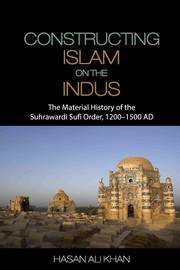Book contents
- Frontmatter
- Dedication
- Contents
- List of Figures
- Foreword
- Preface
- Acknowledgements
- Introduction
- 1 The Suhrawardi Order
- 2 Shams
- 3 The Suhrawardi Order in Uch
- 4 The Wilayat of 'Ali in Twelver Shi'ism, Sufism and the Religion of the Medieval Isma'ilis
- 5 Multan
- 6 The Da'wa and Suhrawardi Monuments at Uch
- Conclusion
- Glossary
- Notes on Referencing
- Bibliography
- Interviews and Fieldwork
- Appendices
- Index
Conclusion
Published online by Cambridge University Press: 05 September 2016
- Frontmatter
- Dedication
- Contents
- List of Figures
- Foreword
- Preface
- Acknowledgements
- Introduction
- 1 The Suhrawardi Order
- 2 Shams
- 3 The Suhrawardi Order in Uch
- 4 The Wilayat of 'Ali in Twelver Shi'ism, Sufism and the Religion of the Medieval Isma'ilis
- 5 Multan
- 6 The Da'wa and Suhrawardi Monuments at Uch
- Conclusion
- Glossary
- Notes on Referencing
- Bibliography
- Interviews and Fieldwork
- Appendices
- Index
Summary
The historical evidence analysed in the introductory chapter examines the dynamics behind pan-Shi'a political agendas, and relationships between different Shi'a groups, in the medieval Muslim world. The rise of various Shi'a states, for the most part through their collaboration and tacit support for each other in the tenth century, resulted in the near extinction of Sunni rule from north-western India to North Africa, with the exception of parts of Khurasan (Afghanistan) and Central Asia. This collaboration was based on the spiritual ideals of Shi'ism, and its claim to the wilayat or vice regency of the first Imam, 'Ali, after Muhammad. Tacit support of the otherwise differing medieval Shi'a sects for each other was also based on this claim. Among them the Isma'ilis and groups related to Twelver Shi'ism collaborated the most, and carved up the Middle East amongst themselves, in the form of the Fatimids and the Buwayhids.
The major reason behind the rise of the various Shi'a factions to power was not political but religious in nature. In spite of adherence to shari'a practices for the most part at the upper echelons of society, the general religiosity that was tolerated, patronised and sometimes even practised by the new rulers was mostly heterodox, and very different from what Shi'ism has become today. It was the infusion and consolidation of these heterodox religious ideas, necessarily Shi'a ones, into popular belief and culture, in areas of Shi'a dominance, which defined the spiritual legacy of medieval Shi'ism. One such area was the middle Indus region with Multan as its capital, which had become a jazira or province of Fatimid Egypt. Fatimid rule in Multan gave rise to syncretic Isma'ili beliefs amongst the population, which included elements of local religiosity and piety. This religiosity was at times crushed by the same agency due to which it arose, in the case of Multan by the Fatimid state, but was also tolerated to an extent, and often reasserted itself. Other examples of such phenomena, which had elements of multi-faith beliefs, were the Druze sect related to the Fatimid Caliph al-Hakim (ruled 996-1021), the Ikhwan al-Safa who flourished in Buwayhid Iraq, and the Qarmati messiah of Persian descent who abolished the shari'a completely at the conjunction of Jupiter and Saturn, and ‘instituted practises which shocked Muslims.’
- Type
- Chapter
- Information
- Constructing Islam on the IndusThe Material History of the Suhrawardi Sufi Order, 1200–1500 AD, pp. 245 - 255Publisher: Cambridge University PressPrint publication year: 2015



